DSPL स्कीमा
संग्रह की मदद से व्यवस्थित रहें
अपनी प्राथमिकताओं के आधार पर, कॉन्टेंट को सेव करें और कैटगरी में बांटें.
यह पेज और इसके लिंक किए गए सबपेज, DSPL एक्सएमएल स्कीमा के बारे में बताते हैं.
यह सामग्री उन उन्नत उपयोगकर्ताओं के लिए है जिन्हें समझना है
भाषा की बारीक जानकारी; तो है कि इस्तेमाल करने वाले ज़्यादातर लोगों
में
डेवलपर गाइड, रिपोर्ट बनाने और उसमें बदलाव करने के लिए काफ़ी होनी चाहिए
DSPL डेटासेट.
Xएसडी फ़ॉर्मैट में डाउनलोड करने के लिए पूरा एक्सएमएल स्कीमा उपलब्ध है
पर
DSPL कोड साइट.
एलिमेंट: dspl
| नाम-स्थान |
http://schemas.google.com/dspl/2010 |
| एनोटेशन |
डीएसपीएल स्पेसिफ़िकेशन में, डेटासेट के बारे में जानकारी दी गई है. डेटासेट है
उसके नेमस्पेस से पहचाना जाता है. डेटासेट में ये चीज़ें शामिल होती हैं
एलिमेंट: - टेबल:
डेटासेट - अवधारणाएं: उपयोगकर्ता-विशिष्ट परिभाषाएं और संरचना
डेटासेट - स्लाइस: डाइमेंशन और मेट्रिक के संयोजन में
डेटासेट - विषय:
डेटासेट |
| डायग्राम |
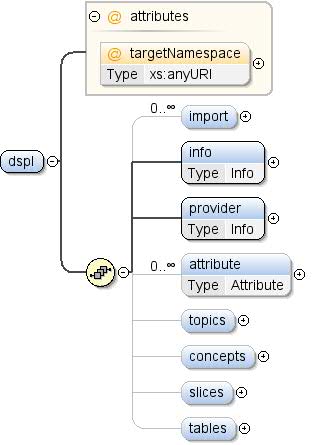 |
| प्रॉपर्टी |
|
| मॉडल |
Import* , info , provider ,
attribute* , विषय{0,1} , कॉन्सेप्ट{0,1} , स्लाइस{0,1} , टेबल{0,1} |
| बच्चे |
एट्रिब्यूट, कॉन्सेप्ट, इंपोर्ट,
info, provider, स्लाइस,
टेबल, विषय |
| इंस्टेंस |
<dspl targetNamespace="">
<import location="" namespace="">{0,unbounded}</import>
<info>{1,1}</info>
<provider>{1,1}</provider>
<attribute concept="" id="">{0,unbounded}</attribute>
<topics>{0,1}</topics>
<concepts>{0,1}</concepts>
<slices>{0,1}</slices>
<tables>{0,1}</tables>
</dspl>
|
| विशेषताएं |
| QName |
टाइप |
तय |
डिफ़ॉल्ट |
इस्तेमाल करें |
टिप्पणी |
| targetNamespace |
xs:anyURI |
|
|
ज़रूरी नहीं |
हर डेटासेट एक टारगेट नेमस्पेस दे सकता है. टारगेट
नेमस्पेस एक यूआरआई है, जो डेटासेट की खास तौर पर पहचान करता है. ज़्यादा के लिए
एक्सएमएल में नेमस्पेस के इस्तेमाल के बारे में जानकारी के लिए, यहां देखें:
http://www.w3.org/TR/REC-xml-names/ अगर कोई targetNamespace नहीं है
दिया जाता है, तो डेटासेट होने पर एक नेमस्पेस जनरेट हो जाएगा
इंपोर्ट किया गया. |
|
| स्रोत |
<xs:element name="dspl">
<xs:annotation>
<xs:documentation>A DSPL specification describes a dataset. A dataset is
identified by its namespace. A dataset is comprised of the
following elements:
- Tables: Data for the concepts and slices defined in the
dataset
- Concepts: User-specified definitions and structures used in
the dataset
- Slices: Combinations of dimensions and metrics present in
the dataset
- Topics: Hierarchical labels used to organise the concepts of
the dataset</xs:documentation>
</xs:annotation>
<xs:complexType>
<xs:sequence>
<xs:element name="import" minOccurs="0" maxOccurs="unbounded">
<xs:annotation>
<xs:documentation>Import directive for external datasets -- modeled after
the XML Schema import directive. In order to use
elements defined in an external dataset, the external
dataset must be referenced using an import directive.</xs:documentation>
</xs:annotation>
<xs:complexType>
<xs:attribute name="namespace" use="required">
<xs:annotation>
<xs:documentation>The namespace of the imported dataset, specified as
a URI. A prefix must be associated with this
namespace before its contents can be referenced. See
[XML Namespaces] for more information about the use
of namespaces and prefixes in XML.</xs:documentation>
</xs:annotation>
</xs:attribute>
<xs:attribute name="location" use="optional">
<xs:annotation>
<xs:documentation>An optional location where the definition of the
imported dataset can be found, specified as a
URL. If the location is omitted, the system
processing this DSPL dataset must already know the
imported dataset.
Implementation note: The Google dataset importer
ignores the location attribute. Any imported dataset
must be known by the Google importer beforehand.</xs:documentation>
</xs:annotation>
</xs:attribute>
</xs:complexType>
</xs:element>
<xs:element name="info" type="Info" minOccurs="1">
<xs:annotation>
<xs:documentation>General information about the dataset.</xs:documentation>
</xs:annotation>
</xs:element>
<xs:element name="provider" type="Info">
<xs:annotation>
<xs:documentation>General information about the dataset provider.</xs:documentation>
</xs:annotation>
</xs:element>
<xs:element name="attribute" type="Attribute" minOccurs="0" maxOccurs="unbounded">
<xs:annotation>
<xs:documentation>Attribute associated with the dataset.</xs:documentation>
</xs:annotation>
</xs:element>
<xs:element name="topics" minOccurs="0">
<xs:annotation>
<xs:documentation>A hierarchy of topics used to organize the contents of
the dataset. The order in which topics are given is
meaningful and should be respected by visualizations
that displays these topics.</xs:documentation>
</xs:annotation>
<xs:complexType>
<xs:sequence>
<xs:element name="topic" type="Topic" maxOccurs="unbounded"/>
</xs:sequence>
</xs:complexType>
</xs:element>
<xs:element name="concepts" minOccurs="0">
<xs:annotation>
<xs:documentation>A list of concepts defined in this dataset.</xs:documentation>
</xs:annotation>
<xs:complexType>
<xs:sequence>
<xs:element name="concept" type="Concept" maxOccurs="unbounded"/>
</xs:sequence>
</xs:complexType>
</xs:element>
<xs:element name="slices" minOccurs="0">
<xs:annotation>
<xs:documentation>A list of slices defined in this dataset.</xs:documentation>
</xs:annotation>
<xs:complexType>
<xs:sequence>
<xs:element name="slice" type="Slice" maxOccurs="unbounded"/>
</xs:sequence>
</xs:complexType>
</xs:element>
<xs:element name="tables" minOccurs="0">
<xs:annotation>
<xs:documentation>A list of tables defined in this dataset.</xs:documentation>
</xs:annotation>
<xs:complexType>
<xs:sequence>
<xs:element name="table" type="Table" maxOccurs="unbounded"/>
</xs:sequence>
</xs:complexType>
</xs:element>
</xs:sequence>
<xs:attribute name="targetNamespace" type="xs:anyURI" use="optional">
<xs:annotation>
<xs:documentation>Each dataset may provide a target namespace. The
target namespace is a URI that uniquely identifies the
dataset. For more information about the use of namespaces in XML,
see:
http://www.w3.org/TR/REC-xml-names/
If no targetNamespace is provided, then a namespace will be
generated when the dataset is imported.</xs:documentation>
</xs:annotation>
</xs:attribute>
</xs:complexType>
</xs:element>
|
एलिमेंट: dspl / इंपोर्ट
| नाम-स्थान |
http://schemas.google.com/dspl/2010 |
| एनोटेशन |
बाहरी डेटासेट के लिए इंपोर्ट डायरेक्टिव -- एक्सएमएल के बाद मॉडल किए गए
स्कीमा इंपोर्ट डायरेक्टिव. किसी बाहरी डोमेन में तय किए गए एलिमेंट का इस्तेमाल करने के लिए
डेटासेट हो, तो बाहरी डेटासेट को
डायरेक्टिव. |
| डायग्राम |
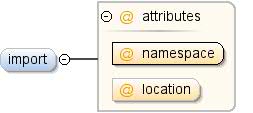 |
| प्रॉपर्टी |
| सामग्री: |
जटिल |
| मिनट समय: |
0 |
| maxOccurs: |
अनबाउंड |
|
| विशेषताएं |
| QName |
टाइप |
तय |
डिफ़ॉल्ट |
इस्तेमाल करें |
टिप्पणी |
| स्थान |
|
|
|
ज़रूरी नहीं |
एक वैकल्पिक जगह, जहां इंपोर्ट किए गए डेटा की परिभाषा
डेटासेट मिल सकता है, जिसे यूआरएल के तौर पर बताया गया है. अगर जगह
जानकारी नहीं दी गई, तो इस DSPL डेटासेट को प्रोसेस करने वाले सिस्टम को पहले से ही जानकारी होनी चाहिए
इंपोर्ट किया गया डेटासेट. लागू करने के लिए नोट: Google डेटासेट
इंपोर्टर, लोकेशन एट्रिब्यूट को अनदेखा करता है. इंपोर्ट किए गए किसी भी डेटासेट को
Google इंपोर्टर को पहले से पता हो जाता है. |
| नेमस्पेस |
|
|
|
ज़रूरी है |
इंपोर्ट किए गए डेटासेट का नेमस्पेस, जिसे
यूआरआई. किसी प्रीफ़िक्स से पहले इस नेमस्पेस के साथ जुड़ा होना चाहिए
कॉन्टेंट का रेफ़रंस दिया जा सकता है. ज़्यादा जानकारी के लिए [एक्सएमएल नेमस्पेस] देखें
में नेमस्पेस और प्रीफ़िक्स के उपयोग के बारे में जानकारी
एक्सएमएल पर लागू होती है. |
|
| स्रोत |
<xs:element name="import" minOccurs="0" maxOccurs="unbounded">
<xs:annotation>
<xs:documentation>Import directive for external datasets -- modeled after
the XML Schema import directive. In order to use
elements defined in an external dataset, the external
dataset must be referenced using an import directive.</xs:documentation>
</xs:annotation>
<xs:complexType>
<xs:attribute name="namespace" use="required">
<xs:annotation>
<xs:documentation>The namespace of the imported dataset, specified as
a URI. A prefix must be associated with this
namespace before its contents can be referenced. See
[XML Namespaces] for more information about the use
of namespaces and prefixes in XML.</xs:documentation>
</xs:annotation>
</xs:attribute>
<xs:attribute name="location" use="optional">
<xs:annotation>
<xs:documentation>An optional location where the definition of the
imported dataset can be found, specified as a
URL. If the location is omitted, the system
processing this DSPL dataset must already know the
imported dataset.
Implementation note: The Google dataset importer
ignores the location attribute. Any imported dataset
must be known by the Google importer beforehand.</xs:documentation>
</xs:annotation>
</xs:attribute>
</xs:complexType>
</xs:element>
|
एलिमेंट: dspl / जानकारी
| नाम-स्थान |
http://schemas.google.com/dspl/2010 |
| एनोटेशन |
डेटासेट के बारे में सामान्य जानकारी. |
| डायग्राम |
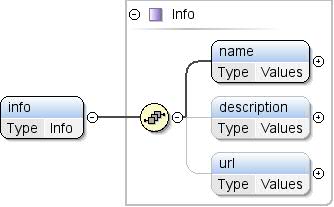 |
| टाइप |
जानकारी |
| प्रॉपर्टी |
| सामग्री: |
जटिल |
| मिनट समय: |
1 |
|
| मॉडल |
name , description{0,1} , यूआरएल{0,1} |
| बच्चे |
ब्यौरा, name, url |
| इंस्टेंस |
<info>
<name>{1,1}</name>
<description>{0,1}</description>
<url>{0,1}</url>
</info>
|
| स्रोत |
<xs:element name="info" type="Info" minOccurs="1">
<xs:annotation>
<xs:documentation>General information about the dataset.</xs:documentation>
</xs:annotation>
</xs:element>
|
एलिमेंट: dspl / कंपनी
| नाम-स्थान |
http://schemas.google.com/dspl/2010 |
| एनोटेशन |
डेटासेट की सेवा देने वाली कंपनी के बारे में सामान्य जानकारी. |
| डायग्राम |
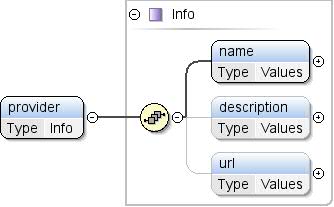 |
| टाइप |
जानकारी |
| प्रॉपर्टी |
|
| मॉडल |
name , description{0,1} , यूआरएल{0,1} |
| बच्चे |
ब्यौरा, name, url |
| इंस्टेंस |
<provider>
<name>{1,1}</name>
<description>{0,1}</description>
<url>{0,1}</url>
</provider>
|
| स्रोत |
<xs:element name="provider" type="Info">
<xs:annotation>
<xs:documentation>General information about the dataset provider.</xs:documentation>
</xs:annotation>
</xs:element>
|
एलिमेंट: dspl / एट्रिब्यूट
| नाम-स्थान |
http://schemas.google.com/dspl/2010 |
| एनोटेशन |
डेटासेट से जुड़ा एट्रिब्यूट. |
| डायग्राम |
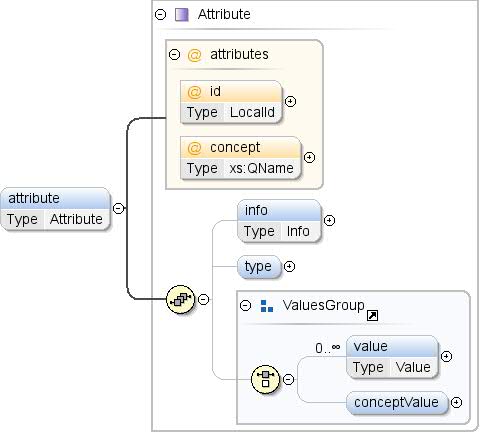 |
| टाइप |
एट्रिब्यूट |
| प्रॉपर्टी |
| सामग्री: |
जटिल |
| मिनट समय: |
0 |
| maxOccurs: |
अनबाउंड |
|
| मॉडल |
info{0,1} , टाइप{0,1} , (वैल्यू*
| conceptValue{0,1}) |
| बच्चे |
conceptValue, info, type,
वैल्यू |
| इंस्टेंस |
<attribute concept="" id="">
<info>{0,1}</info>
<type format="" ref="">{0,1}</type>
</attribute>
|
| विशेषताएं |
| QName |
टाइप |
तय |
डिफ़ॉल्ट |
इस्तेमाल करें |
टिप्पणी |
| सिद्धांत |
xs:QName |
|
|
ज़रूरी नहीं |
वैल्यू से मेल खाने वाले कॉन्सेप्ट का रेफ़रंस
एट्रिब्यूट की वैल्यू डालें. अगर विशेषता किसी प्रकार के बारे में बताती है, तो
दिए गए कॉन्सेप्ट के टाइप से मेल खाना चाहिए.
बाहरी सिद्धांत इस रूप में होना चाहिए
"prefix:other_Concept_id", जहां "prefix" इससे मेल खाता है
बाहरी डेटासेट के नेमस्पेस के लिए इस्तेमाल किया गया प्रीफ़िक्स (एक्सएमएल देखें
नेमस्पेस). |
| आईडी |
LocalId |
|
|
ज़रूरी नहीं |
सिद्धांत विशेषता का आईडी. यह पहचानकर्ता होना चाहिए
यूनीक होनी चाहिए. (एट्रिब्यूट और प्रॉपर्टी में). कॉन्टेंट बनाने
अगर सिद्धांत एट्रिब्यूट दिया गया है, तो आईडी को छोड़ा जा सकता है. इसमें
केस, एक आईडी में आसानी से
में बताया गया है. उदाहरण के लिए <attribute
concept="unit:currency"/> इसके बराबर है
<एट्रिब्यूट आईडी="मुद्रा"
concept="unit:currency"/> |
|
| स्रोत |
<xs:element name="attribute" type="Attribute" minOccurs="0" maxOccurs="unbounded">
<xs:annotation>
<xs:documentation>Attribute associated with the dataset.</xs:documentation>
</xs:annotation>
</xs:element>
|
एलिमेंट: dspl / विषय
| नाम-स्थान |
http://schemas.google.com/dspl/2010 |
| एनोटेशन |
कॉन्टेंट को व्यवस्थित करने के लिए इस्तेमाल किए जाने वाले विषयों की हैरारकी
डेटासेट. वीडियो के विषयों के विषयों का जो क्रम तय किया गया हो वह क्रम के हिसाब से हो
और इन विषयों को दिखाने वाले विज़ुअलाइज़ेशन भी ध्यान में रखते हैं. |
| डायग्राम |
 |
| प्रॉपर्टी |
| सामग्री: |
जटिल |
| मिनट समय: |
0 |
|
| मॉडल |
विषय+ |
| बच्चे |
विषय |
| इंस्टेंस |
<topics>
<topic id="" parentTopic="">{1,unbounded}</topic>
</topics>
|
| स्रोत |
<xs:element name="topics" minOccurs="0">
<xs:annotation>
<xs:documentation>A hierarchy of topics used to organize the contents of
the dataset. The order in which topics are given is
meaningful and should be respected by visualizations
that displays these topics.</xs:documentation>
</xs:annotation>
<xs:complexType>
<xs:sequence>
<xs:element name="topic" type="Topic" maxOccurs="unbounded"/>
</xs:sequence>
</xs:complexType>
</xs:element>
|
एलिमेंट: dspl / विषय / विषय
| नाम-स्थान |
http://schemas.google.com/dspl/2010 |
| डायग्राम |
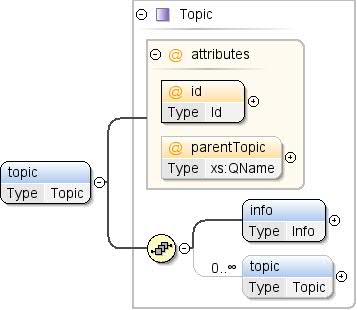 |
| टाइप |
विषय |
| प्रॉपर्टी |
| सामग्री: |
जटिल |
| maxOccurs: |
अनबाउंड |
|
| मॉडल |
जानकारी , विषय* |
| बच्चे |
जानकारी, विषय |
| इंस्टेंस |
<topic id="" parentTopic="">
<info>{1,1}</info>
<topic id="" parentTopic="">{0,unbounded}</topic>
</topic>
|
| विशेषताएं |
| QName |
टाइप |
तय |
डिफ़ॉल्ट |
इस्तेमाल करें |
टिप्पणी |
| आईडी |
आईडी |
|
|
ज़रूरी है |
इस रिपोर्ट में मौजूद विषय का यूनीक आइडेंटिफ़ायर
डेटासेट शामिल है. |
| parentTopic |
xs:QName |
|
|
ज़रूरी नहीं |
इस विषय के पैरंट विषय का आईडी, अगर वह मौजूद है.
अंदर अंडरलाइन किए गए विषयों के लिए, parentTopic के बारे में जानकारी नहीं दी जा सकती
दूसरे विषय. |
|
| स्रोत |
<xs:element name="topic" type="Topic" maxOccurs="unbounded"/>
|
एलिमेंट: dspl / कॉन्सेप्ट
| नाम-स्थान |
http://schemas.google.com/dspl/2010 |
| एनोटेशन |
इस डेटासेट में बताए गए कॉन्सेप्ट की सूची. |
| डायग्राम |
 |
| प्रॉपर्टी |
| सामग्री: |
जटिल |
| मिनट समय: |
0 |
|
| मॉडल |
Concept+ |
| बच्चे |
सिद्धांत |
| इंस्टेंस |
<concepts>
<concept extends="" id="">{1,unbounded}</concept>
</concepts>
|
| स्रोत |
<xs:element name="concepts" minOccurs="0">
<xs:annotation>
<xs:documentation>A list of concepts defined in this dataset.</xs:documentation>
</xs:annotation>
<xs:complexType>
<xs:sequence>
<xs:element name="concept" type="Concept" maxOccurs="unbounded"/>
</xs:sequence>
</xs:complexType>
</xs:element>
|
| नाम-स्थान |
http://schemas.google.com/dspl/2010 |
| डायग्राम |
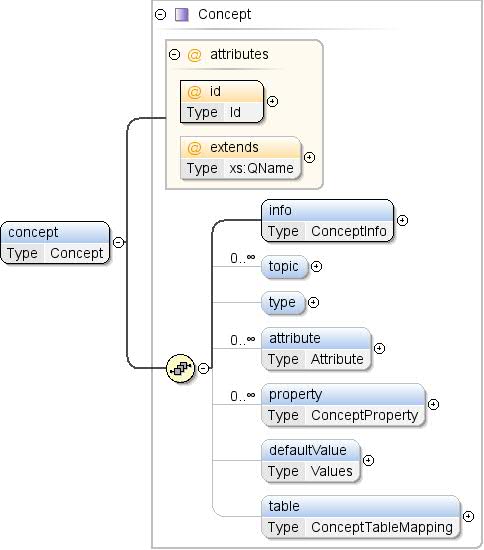 |
| टाइप |
कॉन्सेप्ट |
| प्रॉपर्टी |
| सामग्री: |
जटिल |
| maxOccurs: |
अनबाउंड |
|
| मॉडल |
जानकारी , विषय* , टाइप{0,1} ,
attribute* , प्रॉपर्टी* , defaultValue{0,1} , टेबल{0,1} |
| बच्चे |
attribute, defaultValue, info,
प्रॉपर्टी, टेबल, विषय,
टाइप |
| इंस्टेंस |
<concept extends="" id="">
<info>{1,1}</info>
<topic ref="">{0,unbounded}</topic>
<type ref="">{0,1}</type>
<attribute concept="" id="">{0,unbounded}</attribute>
<property concept="" id="" isMapping="false" isParent="false">{0,unbounded}</property>
<defaultValue>{0,1}</defaultValue>
<table ref="">{0,1}</table>
</concept>
|
| विशेषताएं |
| QName |
टाइप |
तय |
डिफ़ॉल्ट |
इस्तेमाल करें |
टिप्पणी |
| बढ़ावा देता है |
xs:QName |
|
|
ज़रूरी नहीं |
इस कॉन्सेप्ट का यूनीक आइडेंटिफ़ायर
विस्तार. इस कॉन्सेप्ट के बारे में एक ही डेटासेट में बताया जा सकता है
या बाहरी डेटासेट में मौजूद है. किसी बाहरी सोर्स का रेफ़रंस
सिद्धांत "prefix:other_Concept_id" के रूप में होना चाहिए,
जहां "prefix" के नेमस्पेस के लिए इस्तेमाल किया जाने वाला प्रीफ़िक्स है
बाहरी डेटासेट (एक्सएमएल नेमस्पेस देखें). |
| आईडी |
आईडी |
|
|
ज़रूरी है |
सिद्धांत का यूनीक आइडेंटिफ़ायर, जिसे
यूनीक होता है. |
|
| स्रोत |
<xs:element name="concept" type="Concept" maxOccurs="unbounded"/>
|
एलिमेंट: dspl / स्लाइस
| नाम-स्थान |
http://schemas.google.com/dspl/2010 |
| एनोटेशन |
इस डेटासेट में बताए गए स्लाइस की सूची. |
| डायग्राम |
 |
| प्रॉपर्टी |
| सामग्री: |
जटिल |
| मिनट समय: |
0 |
|
| मॉडल |
स्लाइस+ |
| बच्चे |
स्लाइस |
| इंस्टेंस |
<slices>
<slice id="">{1,unbounded}</slice>
</slices>
|
| स्रोत |
<xs:element name="slices" minOccurs="0">
<xs:annotation>
<xs:documentation>A list of slices defined in this dataset.</xs:documentation>
</xs:annotation>
<xs:complexType>
<xs:sequence>
<xs:element name="slice" type="Slice" maxOccurs="unbounded"/>
</xs:sequence>
</xs:complexType>
</xs:element>
|
एलिमेंट: dspl / स्लाइस / स्लाइस
| नाम-स्थान |
http://schemas.google.com/dspl/2010 |
| डायग्राम |
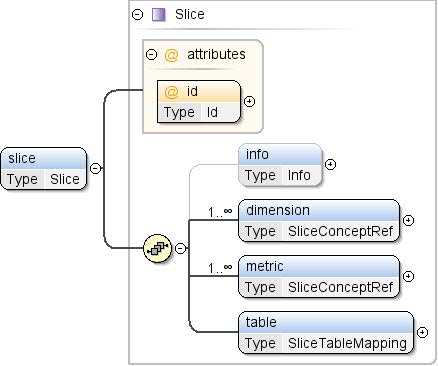 |
| टाइप |
स्लाइस |
| प्रॉपर्टी |
| सामग्री: |
जटिल |
| maxOccurs: |
अनबाउंड |
|
| मॉडल |
जानकारी{0,1} , डाइमेंशन+ , मेट्रिक+
, टेबल |
| बच्चे |
डाइमेंशन, जानकारी, मेट्रिक,
टेबल |
| इंस्टेंस |
<slice id="">
<info>{0,1}</info>
<dimension concept="">{1,unbounded}</dimension>
<metric concept="">{1,unbounded}</metric>
<table ref="">{1,1}</table>
</slice>
|
| विशेषताएं |
| QName |
टाइप |
तय |
डिफ़ॉल्ट |
इस्तेमाल करें |
टिप्पणी |
| आईडी |
आईडी |
|
|
ज़रूरी है |
स्लाइस का यूनीक आइडेंटिफ़ायर. |
|
| स्रोत |
<xs:element name="slice" type="Slice" maxOccurs="unbounded"/>
|
एलिमेंट: dspl / टेबल
| नाम-स्थान |
http://schemas.google.com/dspl/2010 |
| एनोटेशन |
इस डेटासेट में तय की गई टेबल की सूची. |
| डायग्राम |
 |
| प्रॉपर्टी |
| सामग्री: |
जटिल |
| मिनट समय: |
0 |
|
| मॉडल |
टेबल+ |
| बच्चे |
टेबल |
| इंस्टेंस |
<tables>
<table id="">{1,unbounded}</table>
</tables>
|
| स्रोत |
<xs:element name="tables" minOccurs="0">
<xs:annotation>
<xs:documentation>A list of tables defined in this dataset.</xs:documentation>
</xs:annotation>
<xs:complexType>
<xs:sequence>
<xs:element name="table" type="Table" maxOccurs="unbounded"/>
</xs:sequence>
</xs:complexType>
</xs:element>
|
एलिमेंट: dspl / टेबल / टेबल
| नाम-स्थान |
http://schemas.google.com/dspl/2010 |
| डायग्राम |
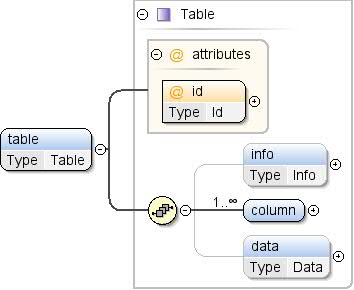 |
| टाइप |
टेबल |
| प्रॉपर्टी |
| सामग्री: |
जटिल |
| maxOccurs: |
अनबाउंड |
|
| मॉडल |
जानकारी{0,1} , कॉलम+ , डेटा{0,1} |
| बच्चे |
column, डेटा, जानकारी |
| इंस्टेंस |
<table id="">
<info>{0,1}</info>
<column format="" id="" type="">{1,unbounded}</column>
<data>{0,1}</data>
</table>
|
| विशेषताएं |
| QName |
टाइप |
तय |
डिफ़ॉल्ट |
इस्तेमाल करें |
टिप्पणी |
| आईडी |
आईडी |
|
|
ज़रूरी है |
डेटासेट शामिल है. |
|
| स्रोत |
<xs:element name="table" type="Table" maxOccurs="unbounded"/>
|
एट्रिब्यूट: dspl / इंपोर्ट / @namespace
| नाम-स्थान |
कोई नेमस्पेस नहीं |
| एनोटेशन |
इंपोर्ट किए गए डेटासेट का नेमस्पेस, जिसे यूआरआई के तौर पर बताया गया है. ऐप्लिकेशन
इस नेमस्पेस के साथ प्रीफ़िक्स जुड़ा होना चाहिए, ताकि कॉन्टेंट को
संदर्भ दिया गया है. एक्सएमएल के इस्तेमाल के बारे में ज़्यादा जानने के लिए, [XML Namespaces] देखें
एक्सएमएल में नेमस्पेस और प्रीफ़िक्स. |
| प्रॉपर्टी |
|
| इस्तेमाल करने वाले |
|
| स्रोत |
<xs:attribute name="namespace" use="required">
<xs:annotation>
<xs:documentation>The namespace of the imported dataset, specified as
a URI. A prefix must be associated with this
namespace before its contents can be referenced. See
[XML Namespaces] for more information about the use
of namespaces and prefixes in XML.</xs:documentation>
</xs:annotation>
</xs:attribute>
|
एट्रिब्यूट: dspl / इंपोर्ट / @location
| नाम-स्थान |
कोई नेमस्पेस नहीं |
| एनोटेशन |
एक वैकल्पिक जगह, जहां इंपोर्ट किए गए डेटा की परिभाषा
डेटासेट मिल सकता है, जिसे यूआरएल के तौर पर बताया गया है. अगर स्थान हटा दिया जाता है, तो
इस DSPL डेटासेट को प्रोसेस करने वाले सिस्टम को,
डेटासेट. लागू करने के लिए नोट: Google डेटासेट इंपोर्टर
जगह की जानकारी देने वाले एट्रिब्यूट के लिए सबमिट करें. इंपोर्ट किए गए किसी भी डेटासेट की जानकारी Google को होनी चाहिए
पहले ही इंपोर्ट कर लें. |
| प्रॉपर्टी |
| इस्तेमाल करें: |
ज़रूरी नहीं |
|
| इस्तेमाल करने वाले |
|
| स्रोत |
<xs:attribute name="location" use="optional">
<xs:annotation>
<xs:documentation>An optional location where the definition of the
imported dataset can be found, specified as a
URL. If the location is omitted, the system
processing this DSPL dataset must already know the
imported dataset.
Implementation note: The Google dataset importer
ignores the location attribute. Any imported dataset
must be known by the Google importer beforehand.</xs:documentation>
</xs:annotation>
</xs:attribute>
|
एट्रिब्यूट: dspl / @targetNamespace
| नाम-स्थान |
कोई नेमस्पेस नहीं |
| एनोटेशन |
हर डेटासेट एक टारगेट नेमस्पेस दे सकता है. टारगेट
नेमस्पेस एक यूआरआई है, जो डेटासेट की खास तौर पर पहचान करता है. ज़्यादा के लिए
एक्सएमएल में नेमस्पेस के इस्तेमाल के बारे में जानकारी के लिए, यहां देखें:
http://www.w3.org/TR/REC-xml-names/ अगर कोई targetNamespace नहीं दिया गया है,
तो डेटासेट होने पर एक नेमस्पेस जनरेट हो जाएगा
इंपोर्ट किया गया. |
| टाइप |
xs:anyURI |
| प्रॉपर्टी |
| इस्तेमाल करें: |
ज़रूरी नहीं |
|
| इस्तेमाल करने वाले |
|
| स्रोत |
<xs:attribute name="targetNamespace" type="xs:anyURI" use="optional">
<xs:annotation>
<xs:documentation>Each dataset may provide a target namespace. The
target namespace is a URI that uniquely identifies the
dataset. For more information about the use of namespaces in XML,
see:
http://www.w3.org/TR/REC-xml-names/
If no targetNamespace is provided, then a namespace will be
generated when the dataset is imported.</xs:documentation>
</xs:annotation>
</xs:attribute>
|
इसका इस्तेमाल करके बनाया गया
oXygen का एक्सएमएल एडिटर.
जब तक कुछ अलग से न बताया जाए, तब तक इस पेज की सामग्री को Creative Commons Attribution 4.0 License के तहत और कोड के नमूनों को Apache 2.0 License के तहत लाइसेंस मिला है. ज़्यादा जानकारी के लिए, Google Developers साइट नीतियां देखें. Oracle और/या इससे जुड़ी हुई कंपनियों का, Java एक रजिस्टर किया हुआ ट्रेडमार्क है.
आखिरी बार 2025-07-25 (UTC) को अपडेट किया गया.
[[["समझने में आसान है","easyToUnderstand","thumb-up"],["मेरी समस्या हल हो गई","solvedMyProblem","thumb-up"],["अन्य","otherUp","thumb-up"]],[["वह जानकारी मौजूद नहीं है जो मुझे चाहिए","missingTheInformationINeed","thumb-down"],["बहुत मुश्किल है / बहुत सारे चरण हैं","tooComplicatedTooManySteps","thumb-down"],["पुराना","outOfDate","thumb-down"],["अनुवाद से जुड़ी समस्या","translationIssue","thumb-down"],["सैंपल / कोड से जुड़ी समस्या","samplesCodeIssue","thumb-down"],["अन्य","otherDown","thumb-down"]],["आखिरी बार 2025-07-25 (UTC) को अपडेट किया गया."],[],["The DSPL XML schema defines a dataset's structure using key components: `tables`, `concepts`, `slices`, and `topics`. The root `dspl` element encapsulates the dataset, utilizing `import` to reference externals, `info` and `provider` for metadata, `attribute` for dataset attributes, and `topics` to hierarchically organize the concepts. `concepts`, `slices`, `tables` are for concept definition, slice definition, and data table, respectively. Each element like `import`, `info`, `provider`, `attribute`, `topic`, `concept`, `slice`, `table` uses specific attributes and child elements for configuration. Each element has a specific cardinality that is defined in the document.\n"]]













